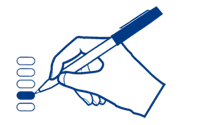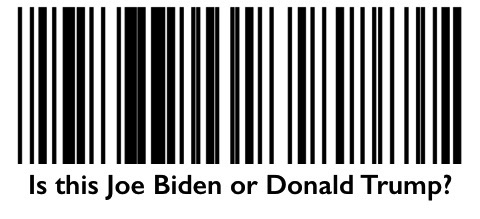Hand marked paper ballots
as a primary voting system.
Experts recommend that most voters use hand marked paper ballots (counted on scanners or by hand), as opposed to machine-marked printouts from hackable ballot marking devices (BMDs). BMDs are, in effect, $3,000-$5,000 electronic pencils that look like traditional voting machines. The only purpose of a BMD is to mark the paper for the voter; the counting is conducted by a separate or integrated scanner.
Who is pushing for Ballot Marking Devices? BMDs were initially designed for voters with disabilities, such as visual impairments, that prevent them from using hand marked paper ballots. But in the past few years, profit-motivated vendors have marketed BMDs for use by all voters. And because there is no universal definition of “paper ballot,” they have misleadingly characterized the machine-marked printouts generated by BMDs as “paper ballots,” thus implying that they can reliably detect and defend against hacking. Jurisdictions throughout the U.S. are flocking to these universal-use BMDs.
But this recent academic report by three esteemed cybersecurity election experts explains the myriad reasons why machine-marked paper ballots from BMDs cannot reliably detect and defend against hacking: https://papers.ssrn.com/sol3/papers.cfm?abstract_id=3375755
BMD negatives abound: In addition to the problems discussed in the above report, relying on universal use BMDs will render elections vulnerable to denial-of-service attacks and power outages. By contrast, with hand marked paper ballots, a DOS attack or power outage would delay only the counting; it would not prevent people from voting.
Moreover, similar to touchscreen voting machines, BMDs are particularly likely to create long lines because they limit the number of people who can vote at once to the number of working machines at the polling place. By contrast, with hand marked paper ballots, many people can concurrently mark their ballots using pens and privacy dividers. The scanning part of the process takes less than a minute. And if scanners break, the ballots can be deposited in sealed bins to be counted later.
On a related point, as with touchscreen voting machines, universal use of BMDs will enable corrupt election officials to manufacture long lines that can swing elections by distributing too few working machines to jurisdictions whose votes they want to suppress.
In short, we must strive to ensure that all jurisdictions use hand marked paper ballots (counted on scanners or by hand) as a primary voting system, with BMDs available only to voters with disabilities who wish to use them.
No barcode BMDs for anyone. Unlike the paper printouts generated by traditional BMDs, the paper printouts generated by most of the new universal use BMDs include both a summary of the voters’ intended selections and a barcode. The barcode, which humans can’t read, is the only part of the printout counted by the scanner. Vendors have been unable to explain why they added the barcodes. But experts say that the barcodes constitute a new and dangerous attack vector, further undermining the integrity of our elections. Counties in the following states (and perhaps others) have recently bought or are planning to buy new barcode BMDs for universal use: GA, FL, PA, WI, OH, TX, KS, AR, DE, NJ, IN, NY, WV, KY, CA, CO (early voting only), and TN. We must stop this dangerous new trend.
No hybrid BMDs for anyone. “Hybrid” BMDs are a unique and especially dangerous type of BMD that combines a BMD and scanner into a single unit. Experts say that at least three popular new hybrids on the market — the ES&S ExpressVote XL, the ES&S ExpressVote (which comes in both a hybrid and non-hybrid version), and the Dominion Image Cast Evolution (ICE) — can add fake votes to paper ballots after they are cast. Counties in the following states (and perhaps others) have recently bought or are planning to buy such BMDs for universal use: PA, OH, KS, DE, NJ, and NY. We must stop this dangerous new trend.
No direct-recording electronic voting machines for anyone. The Help America Vote Act of 2002 allocated billions of dollars for new voting equipment, and many jurisdictions used the money to buy direct-recording electronic (DRE) voting machines. DREs, which typically have a touchscreen interface (though some have a dial), both record and count votes inside the machine. Cybersecurity experts have shown time and again that DREs are unreasonably vulnerable to hacking and malfunction.
• Some DREs are paperless, making manual audits or recounts impossible.
• Some DREs include so-called “Voter Verifiable Paper Audit Trails” (VVPATs), which are almost as bad as paperless machines. Studies show that most voters don’t review VVPATs, are unlikely to notice fraud or error on the face of VVPATs even if they undertake such review, and are unlikely to take action even if they detect a problem. VVPATs are also fragile and difficult to use in an audit. Here’s a link to a video by Emmy Award winning journalist and documentary film maker Lulu Friesdat exposing the many deficiencies of VVPATs: https://nowthisnews.com/videos/politics/how-secure-is- your-vote
• DREs have generally fallen out of favor, but many jurisdictions are still using the DREs they bought years ago, and a few (like Texas) have even bought new DREs. We must strive to ensure that no jurisdictions use DREs in 2020.
Well maintained non-hybrid BMDs (without barcodes) for voters with disabilities. Jurisdictions must give voters with disabilities the option to vote with non-hybrid BMDs that do not count votes with barcodes and that produce a full-face paper ballot, not a summary. Jurisdictions must ensure that these BMDs are well maintained and that poll workers have been trained to use them, requirements that some jurisdictions have thus far failed to meet.

In today’s digital environment, if you can’t see it and touch it, it may not be real.
Hand-marked paper ballots
According to experts, the only way to know if an electronic vote total has been hacked is for voters to have separately recorded their intended selections on paper and for jurisdictions to then use the paper in a manual audit or recount, the results of which can be compared to the electronic total.
But even manual audits or recounts can be “hacked” if the selections on the paper have been marked by a machine, rather than the voter’s own hand. And no matter how that paper is marked, manual audits and recounts can be gamed if the chain of custody between election night and the audit or recount has been compromised.
Additional Resources
Why paper is considered state-of-the-art voting technology
See More
